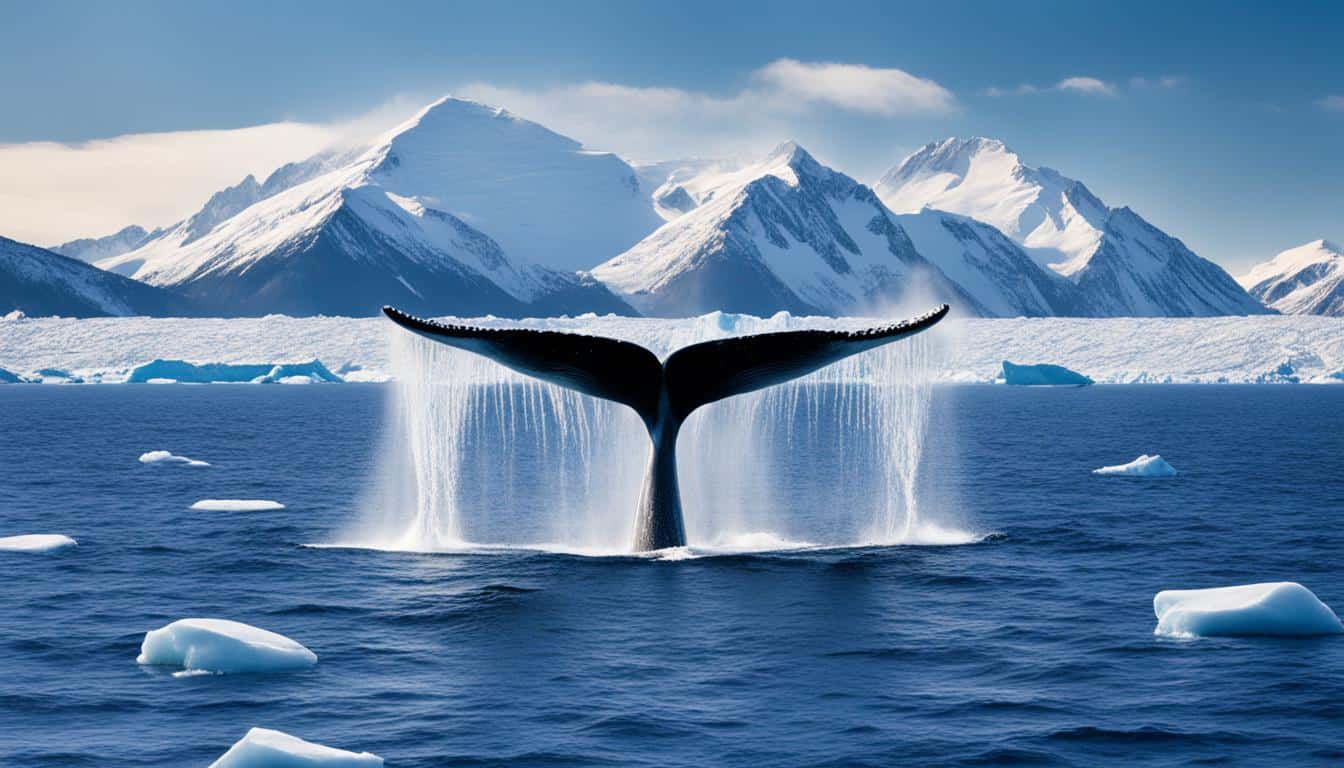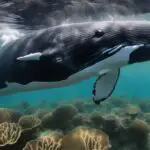Understanding where blue whales live is key to appreciating these huge creatures. So, where do they live? These massive whales live in oceans all over the world. They range from icy polar areas to warm tropical waters. They live in all oceans, except the Arctic.
Their home is shaped by things like food, where they give birth, and temperature changes. Learning about where blue whales live helps us understand their life in the ocean.
Overview of Blue Whale Habitats
Learning about blue whale habitats is key to understanding how they survive and behave. These huge creatures live in places with lots of food and the right geography. Their homes vary a lot because of the ocean’s conditions and the food they find there.
Blue whales mostly live in deep ocean waters, far from the coast. These deep areas have lots of krill, which is their main food. In places with lots of krill, especially in the poles during summer, they can eat well. They stay away from shallow waters to avoid predators and hunt better.
The following table outlines essential aspects regarding their habitats:
| Habitat Type | Characteristics | Importance for Blue Whales |
|---|---|---|
| Deep Ocean Waters | High salinity; deep depths | Optimal hunting grounds for krill |
| Polar Regions | Ice-covered; nutrient-rich waters | Seasonal feeding areas with abundant krill |
| Open Ocean | Vast expanses; minimal human disturbance | Safe migration routes; breeding and feeding |
Knowing where blue whales live shows us how they need big areas for safety and food. By understanding their habitats, we can see how the environment helps these amazing animals live.
Where do blue whales live?
Blue whales live in many marine environments all over the world. They choose their homes based on their needs and what they like. This tells us a lot about their life and what they prefer.
Global Distribution of Blue Whales
Blue whales live in both the Northern and Southern Hemispheres. You can find them off the coasts of Baja California and Monterey. They also live in places like the Gulf of St. Lawrence. These whales like areas with lots of krill, their main food.
Their home changes with the seasons. They move between places for feeding and breeding. This shows how they adapt to different environments.
Marine Environments They Prefer
In summer, blue whales love the cold waters of the poles. This is where they find lots of krill to eat. When winter comes, they head to warmer waters near the Equator to have their babies.
This shows how they can live in many different places. It helps them survive and keep their species going. Here is a table with more info about where blue whales live:
| Aspect | Details |
|---|---|
| Preferred Feeding Grounds | Polar regions rich in krill |
| Breeding Habitats | Warmer equatorial waters |
| Migration Patterns | Seasonal movement between feeding and breeding areas |
| Common Locations | Baja California, Gulf of St. Lawrence |
Blue Whale Migration Patterns
Blue whales have amazing migration patterns that are key to their survival. They move from cold waters with lots of food in the summer to warm areas near the equator in the winter. This journey of thousands of miles shows how well they adapt to different ocean conditions.
These migrations happen when food and ocean temperatures are best. In the summer, they go to the North Pacific and Southern Ocean to eat krill. They follow these paths because they know where to find food, which helps them live and have babies.
These patterns are not just random. They are based on the whales’ natural instincts to deal with changes in their environment. By using the same paths, they increase their chances of surviving. Knowing about blue whale migration helps us protect their homes during their travels.
| Season | Feeding Grounds | Breeding Locations | Typical Migration Distance |
|---|---|---|---|
| Spring to Summer | North Pacific (Alaska) | Central America Coast | Up to 10,000 miles |
| Fall to Winter | Southern Ocean (Antarctica) | Off the coast of Mexico | Up to 7,000 miles |
Understanding blue whale migration patterns is key to knowing more about marine life. Protecting their paths is crucial so future generations can see these amazing creatures. Their journey shows how connected marine ecosystems are and why we must save these places.
Feeding Habits and Habitat Characteristics
Learning about blue whale feeding habits is key to understanding their survival. These huge creatures mainly eat krill, filtering it from the water. They use special techniques like lunging and gulping to eat up to eight tons of krill every day.
Krill as a Main Food Source
Krill is a vital part of the blue whale’s diet. These small crustaceans live in waters full of nutrients, making them easy to find at certain times. Blue whales use their baleen plates to filter huge amounts of water, catching krill for food. This shows how important krill is to blue whales and the balance in the ocean.
Polar Waters and Feeding Grounds
Blue whales live in polar waters during the summer to feed. These areas have lots of krill, perfect for their diet. The cold waters support a lot of krill, drawing blue whales to these areas. They come to these places to eat the krill that’s available seasonally, meeting their huge food needs.
| Feeding Technique | Description | Benefits |
|---|---|---|
| Lunging | Quick movement to the surface, mouth open, engulfing water and prey. | Maximizes intake of krill in a short time. |
| Gulping | Swallowing large volumes of water and krill simultaneously. | Efficient for filtering out krill using baleen plates. |
| Filter Feeding | Using baleen plates to strain krill while expelling seawater. | Allows for the consumption of massive amounts of krill. |
Blue Whale Locations in Different Oceans
Blue whales live in many oceans around the world. They have special places where they can survive best. In the Atlantic and Pacific Oceans, you can find big groups of blue whales. Each group has its own special place that helps them live.
Atlantic and Pacific Habitats
In the Atlantic Ocean, blue whales like the northeastern coast of the United States. They go from New England to Greenland, where they find food. The Gulf of St. Lawrence is a key spot for them.
The Pacific Ocean is also home to many blue whales. They live along the coasts of California and in the Gulf of California. These places have lots of food, which helps the whales live and grow.
Southern Ocean Populations
Blue whales near Antarctica live in the Southern Ocean. This area is very important for their survival. The cold, rich waters are perfect for them to eat and have babies.
| Ocean | Blue Whale Locations | Notable Habitats |
|---|---|---|
| Atlantic | New England, Greenland | Gulf of St. Lawrence |
| Pacific | California Coast, Gulf of California | California Current |
| Southern Ocean | Near Antarctica | Ross Sea, Weddell Sea |
Blue Whale Natural Habitats
Blue whales live in open ocean environments, far from coastal areas. They prefer deeper waters because they need healthy krill populations for food. These vast ocean areas are perfect for their unique way of eating.
Warmer temperate waters are key to their survival. They help blue whale calves grow. These environments give mothers everything their young need to thrive.

| Feature | Description |
|---|---|
| Water Depth | Blue whales like deeper waters for more krill. |
| Temperature | They live in warmer temperate areas, especially when giving birth. |
| Feeding Grounds | They need rich areas for food to meet their energy needs. |
| Migration Routes | They use open ocean paths for their long journeys. |
Learning about blue whale habitats helps us appreciate these amazing creatures more. It shows how important their environment is for their survival in the ocean.
Factors Influencing Blue Whale Distribution
Understanding why blue whales live where they do is key to appreciating them. Their homes are shaped by temperature and ocean currents. These factors affect their migration and how they find food.
During breeding, they go to warmer waters. Cooler areas are important for feeding, especially on krill. These conditions help decide where they live in the ocean.
Temperature and Ocean Currents
Ocean temperature and currents are crucial for blue whales. Warmer waters draw them for breeding. But cooler areas are key for feeding, especially where krill live.
Changes in these conditions can affect their migration and feeding.
Impact of Climate Change on Their Habitats
Climate change has a big impact on blue whales. Rising global temperatures change their homes, affecting their food and migration paths.
Changes in ocean temperatures can reduce krill numbers, making it harder for blue whales to eat. Climate change is a real threat to these animals. It highlights the need for conservation efforts now.
FAQ
Where do blue whales live?
Blue whales live in oceans all over the world, except for the Arctic. They like deep waters full of krill and stay away from shallow coastal areas.
What are the primary habitats of blue whales?
Blue whales live in deep waters with lots of krill, mainly in polar areas during summer. Food and breeding spots are key to where they live.
How do blue whales migrate?
Blue whales migrate from cold feeding grounds in summer to warm breeding grounds near the Equator in winter. They travel thousands of miles for this.
What is the significance of polar waters for blue whales?
Polar waters are vital for blue whales because they have lots of krill, their main food. These areas are crucial for their survival.
In which oceans can blue whales be found?
Blue whales live in the Atlantic and Pacific Oceans. They are found in large numbers along the coasts of Baja California, Monterey, and the Gulf of St. Lawrence. They also live around Antarctica in the Southern Ocean.
What factors influence blue whale distribution?
Many things affect where blue whales live, like ocean temperatures, currents, food, and where they breed. Warmer waters are good for breeding, and cooler waters are better for feeding.
How does climate change affect blue whales?
Climate change is a big threat to blue whales. It changes their homes and food supply. Warmer oceans can hurt krill populations, making it harder for blue whales to survive.







